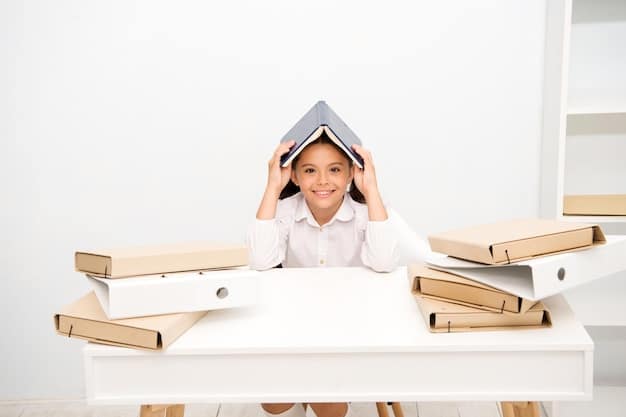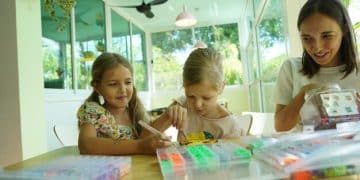Helping Your Child Cope with Anxiety: Practical Strategies for Parents

Helping your child cope with anxiety involves understanding their triggers, creating a supportive environment, teaching coping strategies, and seeking professional help when necessary, empowering them to manage their feelings effectively.
It’s natural for children to experience anxiety from time to time. From school exams to social situations, these feelings are a normal part of growing up. However, when anxiety becomes persistent and starts interfering with your child’s daily life, it’s time to take action. This article provides practical strategies for helping your child cope with anxiety, offering guidance and support for parents navigating this challenging journey.
Understanding Anxiety in Children
Before you can effectively help your child, it’s essential to understand what anxiety is and how it manifests in children. Anxiety is more than just feeling worried; it’s a complex emotional and physiological response to perceived threats.
Recognizing the signs of anxiety in children can be challenging, as they may express their feelings differently than adults. Understanding the root causes can also help you tailor your approach to providing support and reassurance.
Common Signs of Anxiety in Children
Anxiety in children doesn’t always look the same. It can manifest in various ways, and recognizing these signs is the first step toward providing effective support.
- Physical Symptoms: Headaches, stomachaches, and rapid heartbeat.
- Emotional Symptoms: Irritability, restlessness, and excessive worry.
- Behavioral Symptoms: Avoidance of social situations, difficulty concentrating, and sleep disturbances.
Common Causes of Anxiety in Children
Identifying the triggers behind your child’s anxiety is crucial. Several factors can contribute to anxiety in children, ranging from genetic predispositions to environmental stressors.
- Genetic Factors: A family history of anxiety can increase a child’s likelihood of experiencing it.
- Environmental Stressors: School-related pressure, social conflicts, and family changes can trigger anxiety.
- Traumatic Events: Experiencing or witnessing traumatic events can lead to heightened anxiety levels.

Understanding the signs and causes of anxiety can empower you to respond with empathy and support, creating a safe space for your child to express their feelings. By closely observing your child’s behavior and emotional state, you can become more attuned to their unique needs and challenges.
Creating a Supportive Environment
A supportive home environment is pivotal in helping your child manage anxiety. By fostering open communication and providing consistent reassurance, you can create a space where your child feels safe and understood.
Establishing routines and practicing mindfulness together can also contribute to a more stable and calming atmosphere. These strategies can help reduce triggers and provide a sense of predictability and security.
Open Communication and Listening
Creating an environment where your child feels comfortable sharing their feelings is essential. Practice active listening, which involves giving your child your full attention, acknowledging their emotions, and responding with empathy.
Encourage your child to express their worries without judgment. Validating their feelings can make them feel understood and supported, reducing the intensity of their anxiety.
Establishing Routines and Predictability
Children thrive on routine and predictability. Consistent schedules can help reduce anxiety by providing a sense of control and security.
- Regular Bedtimes: Ensure your child gets enough sleep each night.
- Consistent Meal Times: Maintain a regular meal schedule to stabilize blood sugar levels and reduce irritability.
- Predictable Schedules:: Create a daily or weekly schedule that your child can rely on.
Creating a supportive environment involves consistent effort and open-heartedness. By fostering open communication and establishing routines, you can provide your child with the stability and reassurance they need to manage their anxiety effectively.
Teaching Coping Strategies
Equipping your child with effective coping strategies is essential for managing anxiety in the long term. Simple techniques, such as deep breathing exercises and grounding activities, can help your child regulate their emotions and regain a sense of control.
Encouraging problem-solving skills can also empower your child to address anxiety-provoking situations proactively. These skills not only help manage immediate anxiety but also build resilience for the future.
Deep Breathing Exercises
Deep breathing exercises are a simple yet powerful tool for managing anxiety. Teach your child how to take slow, deep breaths to calm their nervous system.
Encourage them to practice the “4-7-8” technique: inhale for 4 seconds, hold for 7 seconds, and exhale for 8 seconds. This can help slow their heart rate and reduce feelings of anxiety.
Grounding Techniques
Grounding techniques can help your child stay present and connected to their surroundings. These exercises can be particularly useful during moments of high anxiety.
- The 5-4-3-2-1 Method: Have your child identify 5 things they can see, 4 things they can touch, 3 things they can hear, 2 things they can smell, and 1 thing they can taste.
- Sensory Focus: Encourage your child to focus on a specific object, paying attention to its color, shape, and texture.
Problem-Solving Skills
Teaching your child how to approach anxiety-provoking situations with a problem-solving mindset can empower them to take control of their feelings.
- Identify the Problem: Help your child clearly define what is causing their anxiety.
- Brainstorm Solutions: Generate a list of possible solutions together.
- Evaluate Options: Discuss the pros and cons of each solution.
By teaching these coping strategies, you’re equipping your child with lifelong skills for managing anxiety. Encourage them to practice these techniques regularly, so they become second nature.
Recognizing and Managing Triggers
Identifying and managing triggers is a vital step in helping your child navigate their anxiety. A trigger is any event, situation, or thought that sets off an anxiety response.
By helping your child become aware of their triggers, you can work together to develop strategies for managing them effectively. This awareness can empower your child to anticipate and prepare for situations that might otherwise lead to heightened anxiety.
Common Anxiety Triggers in Children
Understanding common anxiety triggers in children can help you better identify what might be contributing to your child’s anxiety.
School-related stressors, social interactions, and transitions can all serve as triggers. Recognizing these patterns allows you to proactively support your child and develop coping mechanisms.
Creating a Plan to Manage Triggers
Once you’ve identified your child’s triggers, you can work together to create a plan for managing them. This involves developing strategies to minimize exposure to triggers when possible and teaching your child how to cope when exposure is unavoidable.
- Anticipate and Prepare: Talk about upcoming events that might be anxiety-provoking and brainstorm ways to manage them.
- Modify the Environment: Make small changes to reduce the impact of triggers, such as creating a quiet space for homework.
- Use Coping Strategies: Encourage your child to use the coping strategies they’ve learned to manage anxiety when triggers arise.

Managing triggers is an ongoing process that requires patience and collaboration. By working with your child to identify and address their triggers, you can create a more predictable and manageable environment.
The Role of Physical Health
The intersection of physical health and mental well-being is undeniable, especially when it comes to managing anxiety in children. Ensuring your child maintains a healthy lifestyle can have a profound impact on their ability to cope with stress and anxiety.
Regular exercise, a balanced diet, and sufficient sleep are foundational elements of physical health that directly influence mental well-being. These factors work synergistically to support a child’s overall resilience and emotional stability.
The Importance of Exercise
Physical activity is a powerful tool for managing anxiety. Exercise releases endorphins, which have mood-boosting effects. Regular physical activity can help reduce tension and improve overall well-being.
Encourage your child to engage in activities they enjoy, whether it’s playing sports, dancing, or simply going for a walk. The key is to make exercise a fun and sustainable part of their routine.
Nutrition and Diet
What your child eats can significantly impact their mood and anxiety levels. A balanced diet rich in fruits, vegetables, and whole grains provides essential nutrients that support brain function and emotional regulation.
Limit processed foods, sugary drinks, and excessive caffeine, as these can exacerbate anxiety symptoms. Make sure your child is getting enough protein, healthy fats, and fiber to support stable energy levels and mood.
Prioritizing Sleep
Adequate sleep is essential for managing anxiety in children. Sleep deprivation can lead to irritability, difficulty concentrating, and increased anxiety levels. Establishing a consistent sleep routine can promote better sleep quality.
- Consistent Bedtime: Maintain a regular sleep schedule, even on weekends.
- Relaxing Bedtime Routine: Create a calming routine before bed, such as reading or taking a warm bath.
- Optimal Sleep Environment: Ensure the bedroom is dark, quiet, and cool.
By prioritizing physical health, you’re providing your child with a solid foundation for managing anxiety. A healthy lifestyle supports not only their physical well-being but also their emotional resilience and mental clarity.
When to Seek Professional Help
While many strategies can help manage anxiety at home, sometimes professional intervention is necessary. Recognizing when to seek help and understanding what options are available can make a significant difference in your child’s well-being.
If your child’s anxiety is persistent, severe, or interfering with their daily life, it’s essential to consult with a healthcare professional. Early intervention can prevent anxiety from escalating and improve long-term outcomes.
Signs It’s Time to Seek Professional Help
Knowing the signs that indicate professional help might be needed can ensure your child receives the appropriate support in a timely manner.
If your child’s anxiety is causing significant distress, impacting their school performance, or leading to social isolation, it’s time to seek professional guidance. Additionally, self-harming behaviors or suicidal thoughts warrant immediate attention.
Types of Professional Support Available
Several types of professional support are available for children experiencing anxiety. Each approach offers unique benefits and can be tailored to meet your child’s specific needs.
- Therapy: Cognitive-behavioral therapy (CBT) and play therapy are common approaches that can help children develop coping skills and manage their anxiety.
- Medication: In some cases, medication may be prescribed to help manage anxiety symptoms. This is typically used in conjunction with therapy.
- Counseling: School counselors and family therapists can provide support and guidance for both the child and their family.
Remember, seeking professional help is a sign of strength, not weakness. It demonstrates your commitment to your child’s well-being and can provide them with the tools and support they need to thrive.
| Key Point | Brief Description |
|---|---|
| 💡 Understand Anxiety | Recognize signs and causes in children. |
| 🏠 Supportive Environment | Foster communication and routines. |
| 🧘 Coping Strategies | Teach breathing and grounding techniques. |
| 🍎 Physical Health | Exercise, diet, and sleep impact anxiety. |
FAQ
▼
Common signs include physical symptoms like headaches and stomachaches, emotional symptoms like irritability, and behavioral symptoms such as avoiding social situations.
▼
Foster open communication by actively listening to your child, validate their feelings, and establish consistent routines and predictable schedules to provide a sense of security.
▼
Teach deep breathing exercises like the 4-7-8 technique, grounding techniques such as the 5-4-3-2-1 method, and problem-solving skills to manage anxiety-provoking situations.
▼
Regular exercise, a balanced diet, and adequate sleep play crucial roles in managing anxiety and supporting mental well-being. Prioritize these aspects to enhance your child’s resilience.
▼
Seek professional help if your child’s anxiety is severe, persistent, interferes with daily life, causes significant distress, or if they exhibit self-harming behaviors or suicidal thoughts.
Conclusion
Helping your child cope with anxiety is a journey that requires understanding, patience, and consistent support. By implementing these practical strategies, you can create a nurturing environment where your child feels safe, understood, and empowered to manage their anxiety. Remember, every child is unique, so tailoring your approach to their individual needs is key to fostering their emotional well-being and resilience.





